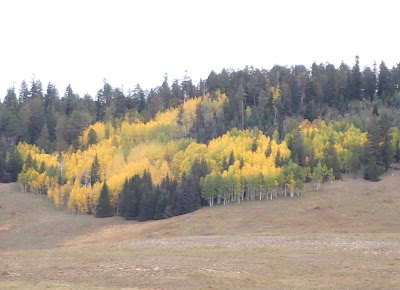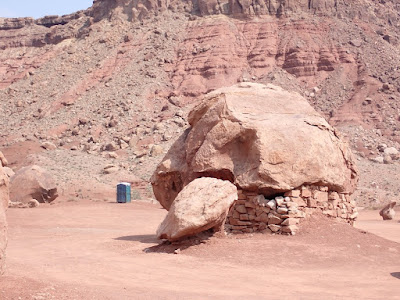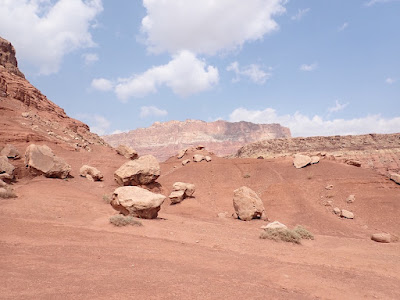4 December 2021



We picked up some items for a picnic lunch, and headed south. The ranger at the park entrance said 
The views of the canyon itself aren't as dramatic from the north as they are from the South Rim. The vistas aren't as broad and 
That's not to say that the northern views aren't still pretty. It just isn't as dramatic. But there were side roads to viewpoints 

And no bison hiding nearby.
We meandered and walked and stopped, and eventually drove back to the Jacob's Lake Inn. We were able to book an adorable little cabin among the trees, and had a very restful night there. If you're ever visiting the North Rim of Grand Canyon, this really is a great place to stay! (Note: the elevation there is nearly 8000 feet!)

For some reason, Arizona 


From Tuba City, we 

This site was called "The Cliff Dwellers," and we expected traditional Native American dwellings carved into the stone cliffs or caves. These weren't like that, these were individual little dwellings built around and under huge boulders that formed part of the little houses! Really rather 
I wandered around, and then started to notice that some of these little buildings had some odd features that I hadn't seen in the several cliff dwellings I've visited. First, the stone walls were formed of squared off blocks of stone, but not 

There were several women selling jewelry and other souvenirs, so I 
Well, these became my 
So of course, once we were in a place with wifi, I had to do some research. What I found was a fascinating story of random chance, survival, and improvisation!
Back in 1927, a vaudeville dancer named Blanche Russell and her husband Bill packed up there belongings and drove to Arizona. Bill had contracted tuberculosis, and they thought the warm dry climate of the southwest would help his medical condition.
Well, as Bill and Blanche drove through this section of Arizona, a bit west of the old Navajo Bridge, their car broke down. There was no nearby town or service, and they were unable to repair whatever was wrong with the car. So they decided to just camp out for the night.
Blanche and Bill decided they liked this little spot, and they were able to build a little house up against one of the rocks. Over the years, they continued to build and eventually established a successful trading post, complete with a restaurant and gas station!
The two stayed here for ten years or so before selling the business and moving on. As the business expanded, it moved down the road a bit - but the original buildings remained, and these are the structures we saw on our visit.
I didn't do the original research - for more information, check out these two websites: https://thatadventurelife.com/2021/08/18/cliff-dwellers-an-interesting-roadside-attraction-in-marble-canyon-az/ and https://wanderwisdom.com/travelogue/Arizonas-Cliff-Dwellers-Lodge-And-Its-Unusual-Origin.
Cool story, isn't it? Almost better than Native Americans choosing to build square buildings on lower ground rather than up in the cliffs.

I wrote about the Cliff Castle, as it's called by the Yavapai-Apache Nation, 


And here's the national park's website: https://www.nps.gov/moca/index.htm
I had fun using my new camera at the Cliff Castle - the photos are much sharper, and I can zoom in and then do a super zoom for really close up photos, even when standing 1000 feet below the building. So yes, more photos of this amazing feat of indigenous architecture!

"Between approximately 1100 and 1400, the Castle neighborhood also included a larger pueblo 
"Nestled in a limestone cliff overlooking the creek, Montezuma's Castle could have housed about 35 people. Including families in nearby pueblos and rock shelters, perhaps 150 to 200 people made up 
"In turn, these people belonged to a network of villagers united by kinship, agriculture, and cultural traditions that stretched dozens of miles along the Verde River and its tributaries, including Beaver Creek, from the Mongollon Rim to the 
"These farming communities thrived until around 1350 to 1400, when people began leaving the Verde Valley, moving toward other population centers to the north and east, including 


There has been some question about what was planted by early Native American communities, 
"For many Native American communities, three seeds - corn, beans, and squash - represent the most important crops. When planted together, the Three Sisters work together to help one another thrive and survive. Utilizing the corn, beans, and squash together in your garden draws upon centuries of Native American agricultural traditions and expertise.
"The crops of corn, beans, and squash are known as the Three Sisters. For centuries these three crops have been the center of Native American agriculture and culinary traditions. It is for good reason as these three crops complement each other in the garden as well as nutritionally.
"Corn provides the tall stalks for the beans to climb so that they are not out-competed by sprawling squash vines. Beans provide nitrogen to fertilize the soil while also stabilizing the tall corn during heavy winds. Beans are nitrogen-fixers, meaning they host rhizobia on their roots that can take nitrogen, a much needed plant nutrient, from the air and convert it into forms that can be absorbed by plant roots. The large leaves of squash plants shade the ground which helps retain soil moisture and prevent weeds."
In some of the lower portions of the castle, there were large flat stones with an indented section. I wondered during the previous visit if these were some kind of stone used for grinding food such as corn or nuts - the base of a grinding system. Turns out I was right - a ranger confirmed that these are grinding stones, called metate, a mealing stone. A large round or oval stone would be used to grind the grains/nuts on the metate.
It amazes me that these items still sit there today!
Okay, more photos, the close ups and the super close ups where you can see the rocks and adobe used to build the castle. Plus the map of our route through Arizona, with each color denoting a different day of travel.
I hope to get in another blog next week to catch everyone up on our exciting life in Arizona. Not that it's that exciting, we are still doing a lot of isolating and trying to stay safe - but we still manage to get out and do things, as well as celebrate the holidays. It is that time of year.























Very fun to see the view from the north rim with glorious quaking aspen yellows-- and your little cabin in the trees! I'm wondering if Bill recovered from his tuberculosis, with all that stone cutting labour in the hot dry Arizona climate! Nice to contrast his "cliff dwelling" with the much earlier castle cliff -- and your new zoom takes great pictures!!
ReplyDeleteI have not been to the north rim. It was interesting to see. Loved the castle and cliff dwellings.
ReplyDeleteThe north rim wasn't open when we visited the GC. It's supposed to be even more glorious than the south rim - but I was overwhelmed the whole time we were there so maybe I would have exploded if I'd been in the north. Glad you had the adventure of visiting this magical place.
ReplyDeleteThanks for another wonderful memory. Oh the power and ease of digital photography. I gave each of our kids a roll of 24 film to take their own photos. I bet all 5 of us on 2 trips to the Grand Canyon and surroundings don't have as many photos as you were able to take on your journey to Tucson. Love the story of Blanche & Bill!
ReplyDeleteWhat a fun read.
ReplyDelete